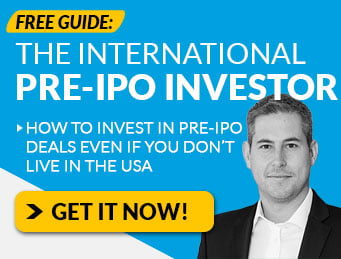Pretty much every investor I know wants to get money into a fast-growing company that can generate outsized returns.
But have you ever stopped to consider why these types of investment opportunities exist in the first place?
Answer: They exist because a company is looking to transfer the financial risk in their business to someone else.
Said another way, management either doesn’t have the funding they need to execute their business plan (or doesn’t want to put that money at risk).
So how do they go get the money they need? That’s the topic of today’s issue.
Let’s dive in,
Jake Hoffberg
P.S. We appreciate that for many people, their life savings is not a game.
However, we choose to present our investor education as a game, because the purpose of games is to develop key skill sets you can use in the real world (and hopefully have fun along the way).
As a reminder, securities sold under Reg CF, Reg A, and Reg D are often considered high risk and speculative in nature. Please do not invest funds you cannot afford to lose, or otherwise need immediate access to.
The Big Idea
Why Investment Opportunities Exist:
A Brief Introduction to Capital Markets
In the same way individuals go to the supermarket to buy groceries, companies go to the Capital Markets to buy money.
Just like any market, there’s an assortment of vendors who all have “money for sale” and are willing to sell it for the right price/terms.
Understanding how this dynamic works is really important for you as a private market investor!
Whether you realize it or not, investors are in the business of buying and selling different types of investment products.
And just like literally every business in the world that has inventory… your core activity is buying, managing, and selling your inventory to achieve maximum potential profits with minimal risk.
As we’ve already learned in our lesson on portfolio construction, your model portfolio provides a guide on what types of inventory – and in what quantities – your business is going to carry, as well as the desired profit margins of each “product” in your store.
And if you want your “investing business” to make money, it means you need to know what I call “The 5 S’s”…
- Specification: What type of Investment Products make sense in the context of your model portfolio
- Sourcing: Where to find these Investment Products
- Selecting: How to perform proper due diligence and underwriting to determine the risk:reward profile of the Investment Products
- Supporting: What check size you’re comfortable writing
- Selling: Managing your position over time to optimize returns
The job of every CEO is to constantly acquire and deploy capital into the best long term opportunities.
General speaking, there are three main sources of capital:
- Retained Earnings: This happens when the business sells products and services to customers. This is the best form of capital as it comes with no dilution and limited risk (i.e., refunds and chargebacks).
- Debt Capital: This happens when the business borrows money from a lender, that’s repayable with interest. Sometimes this is collateralized by company assets (secured debt) and sometimes it’s not (unsecured debt).
- Equity Capital: This happens when the business sells its stock to investors (often sold as “preferred equity” or “common equity”).
As the company raises multiple rounds of financing by selling multiple types of investment products under varying terms, it forms something called a “Capital Stack.”
Each financial product has a position on the Capital Stack that determines who gets paid how much – in what order – should the company be liquidated (either through sale or bankruptcy).

Here’s an example you might find yourself in…
Let’s say you buy Common Stock in an early stage company at a $10m valuation. Several years later, the company is sold for $100m.
At this point, you might be thinking “I’m up 10x!” Assuming there was no additional dilution from any other financing round, you’d be correct.
Except for one thing; you have to take into consideration your position on the Capitalization Table (or “Cap Table”).
Here’s why…
- Whenever a company is liquidated, people get paid back in a certain order (called the “Liquidation Preference”).
Technically, the tax man would get paid first, and employees are entitled to any unpaid wages…
But after that, everything is decided by the Cap Table, and where you sit on it.
At the very top of the stack are the Senior Debt holders.
Because this debt is secured by the company’s assets, it is the cheapest form of capital a company can buy.
Why? Because that debt is in “first position” to be repaid, which makes it the lowest risk.
This Senior Lender is often a commercial bank of some kind, and this Investment Product is typically a low risk, low return proposition for the bank.
For example, this could be a revolving line of credit or a term loan.
Next up are the Subordinated Debt holders.
While subordinate is an unfortunately fancy word, it simply means they are next in line to get paid back.
Because of this, Subordinated Debt is higher risk, and therefore commands a higher interest rate than the Senior Debt.
These are typically things like high yield bonds (aka “Junk Bonds”) that represent a higher risk, higher return proposition compared to Senior Debt.
After that are the Mezzanine Debt holders.
Yet another unfortunately fancy word, but this debt is structured a bit differently than the first two…
Unlike Senior Debt and Subordinated Debt – which require the borrower to pay back the loans, plus interest, over a fixed period of time…
Because this type of debt is third in line, the lender wants an extra “kicker” to make it worth the risk.
Not only is the lender expecting some sort of cash repayment terms on the loan…
It often comes with a provision that in the event of a default, the debt will convert to equity (called a Convertible Note).
It might also come with additional Warrant Coverage – which gives the lender the option to buy more equity in the company, at a fixed price, over a specified period of time.
Preferred Equity is next in line after the debt holders have been paid.
As the name implies, Preferred Stockholders have a preference, and that preference is to get paid before the common shareholders.
Oftentimes institutional investors – like venture capitalists – will structure deals that involve them getting preferred shares with voting rights, board seats, and various “minority control” provisions designed to protect the interests of the Preferred share class.
And at the very bottom of the Capital Stack…
Common Equity is the last in line to get paid.
Generally speaking, the founders of the company – and their employees – are the ones who own Common Equity.
The reason why is simple: in the beginning, everyone on the Cap Table has ownership under the same terms as everyone else.
So why would any early stage investor want Common Equity in a privately owned company?
Answer: It’s all about creating investor alignment around the liquidity strategy.
Playbook
Exit Strategy:
Why I Prefer IPOs Over M&A
For those seeking outsized returns by investing in early stage companies, the earlier you get in, the more “subordination risk” you have should the company get acquired.
In fact, for VC/PE firms who seek to take minority control of the business, one of the reasons they prefer to sell the company privately is because they stand to make the most amount of money with the least amount of risk.
Why go public – and risk the stock price moving against you – when you can sell it in a private transaction, capture your entire liquidation preference, and who cares what happens to the common shareholders (i.e., the founders and employees)?
That’s why we have a heavy bias toward management teams who understand that small balance checkwriters keep management control… and if they can maintain control of their Capital Stack, an IPO is often the best way to deliver returns to all the common shareholders who took the biggest risks.
Let’s take a quick look at how this capital stack is built in the real world.
If we look at the typical funding lifecycle, it looks something like this…

In the beginning, companies raise “Seed Capital” in order to turn their idea into a product. To raise capital, they will either need to self-fund the company, or sell Common Equity to “Friends, Family, and Fools” (yes, that’s a real term).
Then, once they’ve developed the minimum viable product, they enter the “Early Stage;” to raise capital, they will likely need to expand their retail shareholder base to continue to sell Common Equity, or they will likely be forced to sell Preferred Equity to institutional investors (like venture capital and private equity).
They also may have access to Debt capital that is likely quite expensive (often referred to as “Venture Debt”).
As they get traction and enter the “Later Stage,” they start to unlock cheaper forms of Debt capital from both bank and non-bank lenders.
Lastly, once the company matures and is large enough, becoming a publicly traded company often opens up a plethora of financing opportunities, in addition to providing liquidity for early shareholders.
Final Thoughts
I’m obviously biased, but I personally think exempt offering frameworks created by The JOBS Act are the single most important innovation in banking and capital markets that no one is talking about.
Instead of raising rather “expensive” capital from institutions and financiers – who are primarily motivated by generating financial returns for themselves and their LPs, regardless of the impact it has on other shareholders…
Founders can raise “friendly” capital from employees, customers, vendors, or other stakeholders – who are likely motivated by the long term success of the company and its continued ability to create jobs, solve problems, and otherwise create shareholder value.
But in order to unlock this opportunity, it means we have to help founders understand how Crowdfunding fits into a long term capital raising – and company building – strategy…
And it means we have to help everyday people become more educated and informed investors who feel confident investing in early stage companies.
That’s why we’re dedicated to producing what we believe to be true thought leadership and world class investor education materials.
Because you – a member of our growing Equifund Community – are the reason companies want to list on the Equifund Crowd Funding Portal.
And we want you to have proper expectations – along with the right tools and training programs – when it comes to investing in Private Capital.
- The more educated you are, the more confident you’ll feel when investing…
- The more confident you feel, the more likely it is you’ll invest more – and more often – in the opportunities listed on the Portal…
- The more our community invests, the more likely it is Issuers will have success on the Portal…
- The more success Issuers have, the more likely it is that more – and higher quality – Issuers will come to the Portal…
- The higher quality of the Issuer, the more likely it is they will deliver returns for the investor…
- The more returns our Issuers deliver to Investors, the easier it is to grow our community…
Until one day, we – the Equifund community – become the #1 option for companies who want to prepare for life as a public company.





